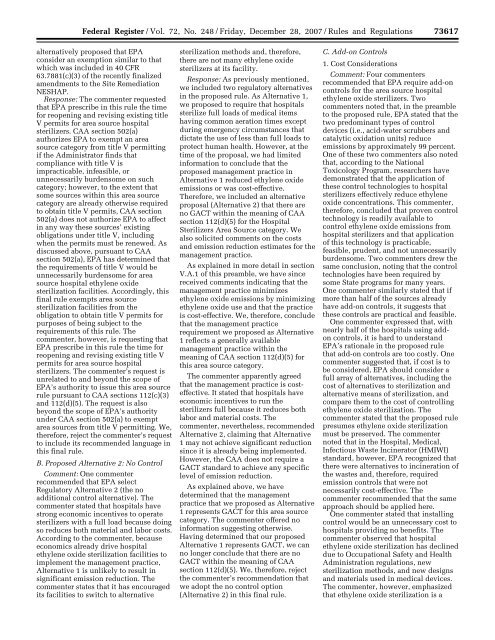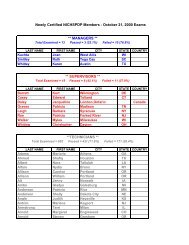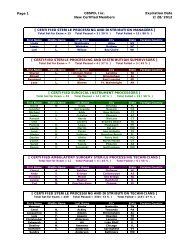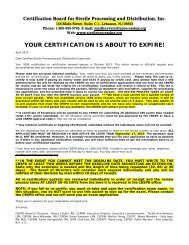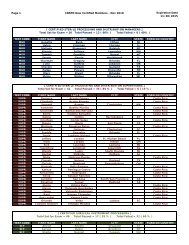Hospitals: Ethylene Oxide Sterilizers - US Environmental Protection ...
Hospitals: Ethylene Oxide Sterilizers - US Environmental Protection ...
Hospitals: Ethylene Oxide Sterilizers - US Environmental Protection ...
Create successful ePaper yourself
Turn your PDF publications into a flip-book with our unique Google optimized e-Paper software.
Federal Register / Vol. 72, No. 248 / Friday, December 28, 2007 / Rules and Regulations73617pwalker on PROD1PC71 with RULESalternatively proposed that EPAconsider an exemption similar to thatwhich was included in 40 CFR63.7881(c)(3) of the recently finalizedamendments to the Site RemediationNESHAP.Response: The commenter requestedthat EPA prescribe in this rule the timefor reopening and revising existing titleV permits for area source hospitalsterilizers. CAA section 502(a)authorizes EPA to exempt an areasource category from title V permittingif the Administrator finds thatcompliance with title V isimpracticable, infeasible, orunnecessarily burdensome on suchcategory; however, to the extent thatsome sources within this area sourcecategory are already otherwise requiredto obtain title V permits, CAA section502(a) does not authorize EPA to affectin any way these sources’ existingobligations under title V, includingwhen the permits must be renewed. Asdiscussed above, pursuant to CAAsection 502(a), EPA has determined thatthe requirements of title V would beunnecessarily burdensome for areasource hospital ethylene oxidesterilization facilities. Accordingly, thisfinal rule exempts area sourcesterilization facilities from theobligation to obtain title V permits forpurposes of being subject to therequirements of this rule. Thecommenter, however, is requesting thatEPA prescribe in this rule the time forreopening and revising existing title Vpermits for area source hospitalsterilizers. The commenter’s request isunrelated to and beyond the scope ofEPA’s authority to issue this area sourcerule pursuant to CAA sections 112(c)(3)and 112(d)(5). The request is alsobeyond the scope of EPA’s authorityunder CAA section 502(a) to exemptarea sources from title V permitting. We,therefore, reject the commenter’s requestto include its recommended language inthis final rule.B. Proposed Alternative 2: No ControlComment: One commenterrecommended that EPA selectRegulatory Alternative 2 (the noadditional control alternative). Thecommenter stated that hospitals havestrong economic incentives to operatesterilizers with a full load because doingso reduces both material and labor costs.According to the commenter, becauseeconomics already drive hospitalethylene oxide sterilization facilities toimplement the management practice,Alternative 1 is unlikely to result insignificant emission reduction. Thecommenter states that it has encouragedits facilities to switch to alternativesterilization methods and, therefore,there are not many ethylene oxidesterilizers at its facility.Response: As previously mentioned,we included two regulatory alternativesin the proposed rule. As Alternative 1,we proposed to require that hospitalssterilize full loads of medical itemshaving common aeration times exceptduring emergency circumstances thatdictate the use of less than full loads toprotect human health. However, at thetime of the proposal, we had limitedinformation to conclude that theproposed management practice inAlternative 1 reduced ethylene oxideemissions or was cost-effective.Therefore, we included an alternativeproposal (Alternative 2) that there areno GACT within the meaning of CAAsection 112(d)(5) for the Hospital<strong>Sterilizers</strong> Area Source category. Wealso solicited comments on the costsand emission reduction estimates for themanagement practice.As explained in more detail in sectionV.A.1 of this preamble, we have sincereceived comments indicating that themanagement practice minimizesethylene oxide emissions by minimizingethylene oxide use and that the practiceis cost-effective. We, therefore, concludethat the management practicerequirement we proposed as Alternative1 reflects a generally availablemanagement practice within themeaning of CAA section 112(d)(5) forthis area source category.The commenter apparently agreedthat the management practice is costeffective.It stated that hospitals haveeconomic incentives to run thesterilizers full because it reduces bothlabor and material costs. Thecommenter, nevertheless, recommendedAlternative 2, claiming that Alternative1 may not achieve significant reductionsince it is already being implemented.However, the CAA does not require aGACT standard to achieve any specificlevel of emission reduction.As explained above, we havedetermined that the managementpractice that we proposed as Alternative1 represents GACT for this area sourcecategory. The commenter offered noinformation suggesting otherwise.Having determined that our proposedAlternative 1 represents GACT, we canno longer conclude that there are noGACT within the meaning of CAAsection 112(d)(5). We, therefore, rejectthe commenter’s recommendation thatwe adopt the no control option(Alternative 2) in this final rule.VerDate Aug2005 23:53 Dec 27, 2007 Jkt 214001 PO 00000 Frm 00045 Fmt 4700 Sfmt 4700 E:\FR\FM\28DER1.SGM 28DER1C. Add-on Controls1. Cost ConsiderationsComment: Four commentersrecommended that EPA require add-oncontrols for the area source hospitalethylene oxide sterilizers. Twocommenters noted that, in the preambleto the proposed rule, EPA stated that thetwo predominant types of controldevices (i.e., acid-water scrubbers andcatalytic oxidation units) reduceemissions by approximately 99 percent.One of these two commenters also notedthat, according to the NationalToxicology Program, researchers havedemonstrated that the application ofthese control technologies to hospitalsterilizers effectively reduce ethyleneoxide concentrations. This commenter,therefore, concluded that proven controltechnology is readily available tocontrol ethylene oxide emissions fromhospital sterilizers and that applicationof this technology is practicable,feasible, prudent, and not unnecessarilyburdensome. Two commenters drew thesame conclusion, noting that the controltechnologies have been required bysome State programs for many years.One commenter similarly stated that ifmore than half of the sources alreadyhave add-on controls, it suggests thatthese controls are practical and feasible.One commenter expressed that, withnearly half of the hospitals using addoncontrols, it is hard to understandEPA’s rationale in the proposed rulethat add-on controls are too costly. Onecommenter suggested that, if cost is tobe considered, EPA should consider afull array of alternatives, including thecost of alternatives to sterilization andalternative means of sterilization, andcompare them to the cost of controllingethylene oxide sterilization. Thecommenter stated that the proposed rulepresumes ethylene oxide sterilizationmust be preserved. The commenternoted that in the Hospital, Medical,Infectious Waste Incinerator (HMIWI)standard, however, EPA recognized thatthere were alternatives to incineration ofthe wastes and, therefore, requiredemission controls that were notnecessarily cost-effective. Thecommenter recommended that the sameapproach should be applied here.One commenter stated that installingcontrol would be an unnecessary cost tohospitals providing no benefits. Thecommenter observed that hospitalethylene oxide sterilization has declineddue to Occupational Safety and HealthAdministration regulations, newsterilization methods, and new designsand materials used in medical devices.The commenter, however, emphasizedthat ethylene oxide sterilization is a


